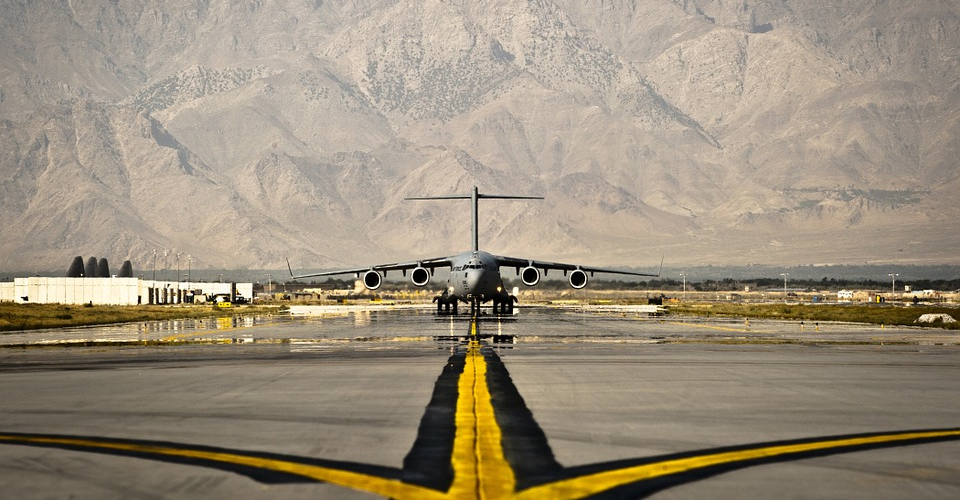What Areas are Considered Restricted Airspace for Drone Flight?
As drones have become more and more popular in recent years, the FAA has started to consider them essential parts of national airspace. As this same airspace is shared commercial flights, private planes, and military aircraft, flight restrictions had to be made to avoid any drone-related accidents. Knowledge of restricted airspace is highly important for drone pilots, regardless of whether you are flying commercially or just for leisure.
In this article, we take a look at all examples of restricted airspace and the hazards that drone pilots can expect to encounter in them.
Near airports
Drone pilots are generally prohibited from flying near airports because of increased air traffic. In an airport environment, drones pose a hazard because they are difficult to see from the perspective of pilots of commercial flights and other manned aircraft.
The most prevalent restricted airspace are the areas surrounding airports. The extent of this type of restricted airspace depends on how big the airport is and how much air traffic it normally receives. For instance, the restricted airspace surrounding some of the busiest airports in the country can extend up to 30 nautical miles at high altitudes and up to 10 miles near the ground. This “upside-down wedding cake” orientation is a common characteristic across all restricted airspace associated with airports.
A drone pilot with a Part 107 license can fly near an airport, but only if permitted by air traffic control (ATC). If you are a recreational drone pilot, according to the Special Rule for Model Aircraft, you will also need to secure permission from the airport operator and the ATC to fly within five miles of an airport.

PART 107 Made Easy
- 161 Question and Answer Study Guide
- 105 pages of illustrated content
- Covers all parts of the Part 107 test
- $97 of value for free
Stadiums and sporting events
According to FAA rules, flying drones in or near (three nautical mile radius) stadiums is prohibited starting one hour before and ending one hour after the scheduled time of major sporting events. By default, these events include:
- Major League Baseball
- NCAA Division One Football
- NASCAR Sprint Cup, Indy Car, and Champ Series races
- National Football League
The list is by no means exhaustive, and other sporting events can be granted Temporary Flight Restrictions (TFRs) as the FAA deems fit. Any drone flight over an area with an active TFR is highly prohibited and illegal.
Sports events are particularly sensitive against drone flight due to a high density of people who could end up injured if a drone happens to crash. Both commercial and recreational drone rules also prohibit any type of drone flight over people who are not participating in the activity.
Washington, DC
If there’s any part of the country that is most restrictive against drone flight, then it’s definitely the airspace around Washington, DC. Home to the White House, Washington, DC maintains a Special Flight Rules Area (SFRA) within a 30-mile radius from the Ronald Reagan Washington National Airport. The SFRA itself is divided into two sections: the outer 30-mile radius ring, and an inner 15-mile radius ring. Flight restriction rules are different across these two zones.
Within the 15-mile inner radius, all drone of flight is strictly prohibited unless with specific FAA authorization. This authorization is normally only granted to government firms for matters of security. Outside of the 15-mile inner ring but within the 30-mile outer ring, drone flight for commercial and recreational use is allowed but only under the usual operating conditions:
- Only drones that weigh less than 55 lbs. are allowed
- All drones must be registered with the FAA and properly marked with the unique registration number
- Drones can only fly below 400 ft. altitude and must remain within visual line-of-sight
- Drones must never fly near other aircraft, unmanned or otherwise
- Drone flight is only allowed in clear weather conditions
Military bases and facilities
In an announcement made by the FAA in April 2017, the agency provided a list of more than a hundred military facilities with special flight restrictions. The list includes Department of Defense (DOD) facilities, and US federal and security and intelligence agencies. The authority of the FAA to enforce such a list falls under 14 CFR Chapter 99.7 or the “Special Security Instructions” that was meant to address national security concerns about unauthorized drone flight.
The list of military facilities with restricted airspace was further expanded in February 2019 with about 40 additional entries, although most of them were for prisons and other correctional facilities.
Aside from having an unusual amount of traffic, drone flight over or near military facilities is discouraged as they can be used as surveillance tools. There may also be invisible hazards in military areas such as artillery firing or aerial gunnery.
Emergency and rescue operations
Unless you are involved as a responder, you are prohibited from flying your drone over emergencies and natural disasters such as wildfires or hurricanes. Having unauthorized drones flying over disaster areas can get in the way of aerial disaster response like firefighting or search and rescue. There have even been situations where airborne firefighters had to be grounded because of the presence of unauthorized drones in the same airspace. As you can imagine, this is massively counterproductive to rapid disaster response.
Normally, the FAA will issue a TFR over an active wildfire. However, the TFR is not necessary for the FAA to cite you for a violation if you do decide to fly over the wildfire. After all, it’s not like you are going to stumble into a wildfire by accident.
Prisons
Drones have become a major source of headaches for prisons and correctional facilities. In prisons all over the world, there have been numerous reports of contraband smuggling using drones flying over exercise yards. This has become such a serious problem that some prisons have started to serve as a testing ground for pioneering anti-drone technology.
As a response to these incidences, the FAA worked with the Department of Justice (DOJ) and Department of Homeland Security (DHS) to come up with a list of prisons and correctional facilities with active flight restrictions. The list includes around 30 facilities. Drone pilots found in violation of these flight restrictions may face civil penalties and criminal charges.
Landmarks and national monuments
In an announcement released by the FAA and the Department of the Interior (DOI) in September 2017, all drone flight near the country’s most famous landmarks and monuments has been prohibited. The list of sites in this announcement is pretty short but includes just about all famous landmarks you could name: the Folsom Dam, Hoover Dam, Mount Rushmore, and the Statue of Liberty. The flight restriction will be in effect within 400 feet of lateral distance from each of the sites in the list.
Drone pilots can get an authority to fly within the restricted landmark areas, but an application will have to be lodged with the FAA and evaluated individually. Any drone operator found to be violating these flight restrictions can face civil penalties and criminal charges.
DOE facilities
The FAA and the Department of Energy (DOE) made a joint announcement in December 2017 regarding flight restrictions over DOE facilities and nuclear sites. The list of restricted areas included laboratories, research centers, and nuclear assembly facilities. These restrictions were put in place in the interest of national security.
US Coast Guard and Naval sites
In one of the more recent announcements, the FAA in partnership with the DOJ and DHS specified US Coast Guard facilities with active flight restrictions. The announcement, dated June 2018, included a list of shipyard and US Coast Guard bases. Again, these restrictions were implemented to serve the interests of national security. The list of sites was further expanded in May 2018 and again on February 2019.
Drone pilots are required to maintain a distance of 3000 feet laterally and 1000 feet vertically the sites listed in the flight restrictions. Otherwise, the drone operator may be liable to face civil penalties and criminal charges, as usual.
Is it possible to fly in restricted airspace?
While drone flight in restricted airspace is heavily regulated, it’s still possible to get the authority to do so. As different institutions are in charge of the various types of restricted airspace, there isn’t really a single procedure to follow to secure this authorization. According to the FAA, a drone operator may be granted the permission to fly in the restricted area if they satisfy one or more of the following qualifications:
- The drone flight operation has been approved by the facility contact based on the criteria established by the relevant federal agency in coordination with the FAA
- The drone flight operation is being conducted in support of national defense, homeland security, firefighting, search and rescue, law enforcement, or disaster response
- The drone flight operation is being conducted in support of governmental interest and approved by the FAA’s System Operations Support Center
As you can see, the qualifications aren’t exactly geared toward casual drone flight. If you’re flying your drone just for fun, it’s probably best to turn away.
How can I best avoid flying in restricted airspace?
With so many restricted airspace types, keeping track of all of them can prove overwhelming. How can an average drone pilot make sure that they are not violating airspace flight restrictions?
Fortunately, you won’t need to open up sectional charts every time you go out for a drone flight mission. All you need to do is to install B4UFLY, the official FAA mobile app, into your device. With B4UFLY, you can view an interactive map of your surroundings where different airspace types are highlighted. You can see the terms of each flight restriction and check if you are within 5 miles of any airport. Finally, the app lets you know if your drone flight in your target location is prohibited or if you need to take any action to secure the proper authorization.
Even drone manufacturers have started to incorporate measures into their drone’s firmware to prevent drone pilots from veering into restricted airspace. In their recent firmware updates, DJI has introduced a No-Fly Zone feature that automatically stops their drones from flying into restricted areas or prevents them from taking off within these areas. DJI has also incorporated a way by which these areas will be unlocked, either by simply providing your drone registration number or by showing evidence that you have documented authorization to fly in these areas.
Our advice is to double-check from more than one source whenever you fly your drone in an unfamiliar area. Information on restricted airspace is pretty easy to come by nowadays, so ignorance should no longer be an excuse.
Final thoughts
As drones become even more important elements of national airspace, steps had to be taken to keep security-critical areas and important landmarks from wayward drones. As you might have noticed, the FAA seems to release even more restrictions over time. This is just evidence that drone flight rules have evolved and will continue to evolve with prevailing circumstances.
While not being able to fly your drone in so many areas in the country feels restrictive, we can’t help but feel that there are good justifications behind every single one of these restrictions. All things considered, the restrictions even seem to be reactionary to drone-related problems that are already happening. Unless the malicious use of drones stops, we will probably see drone flight rules even become more restrictive. The best that we can do right now as drone pilots is to comply with current flight rules in a bid to prove that drone flight can be safe for everyone.


